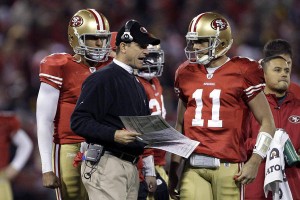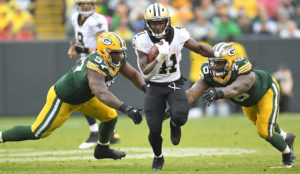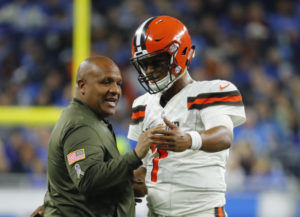
Keenum and Thielen are an unlikely pair driving the best team in the NFC.
This year’s Super Bowl will be played in Minneapolis, Minnesota at
U.S. Bank Stadium, the second-year facility that hosts the Minnesota Vikings during the regular season. That game will be the 52nd Super Bowl, and 44 of the first 51 were played at the home stadium of an AFL or NFL team.
First, let’s look at the seven — well, really three- exceptions where the game was played at a non-NFL/AFL site. In two of the three cases, a home region team has made it to that Super Bowl.
- The Oilers played at Rice Stadium for their first three seasons before moving to the Astrodome. Super Bowl VIII, featuring the Dolphins and Vikings, was award to Houston and Rice Stadium (likely over the Astrodome because of the larger seating capacity). The Oilers went 1-13 that season.
- The Super Bowl concluding the 1979 season was played at the Rose Bowl, which has been the site for 5 Super Bowls. That year, the Los Angeles Rams won the NFC. The Rams played home games at the Coliseum, a mere 25 minutes from the Rose Bowl.
Park in San Francisco.
- Five years later, the 49ers — who played home games at Candlestick Park — won the NFC. That year, the Super Bowl was played at Stanford Stadium in Palo Alto, the only other non-NFL venue to host a Super Bowl. Stanford Stadium is just 30 miles from Candlestick Park in San Francisco.
In the other 44 instances prior to 2017, the host team (or teams, in the case of the Jets and Giants with regards to Super Bowl XLVIII) failed to make the postseason in 37 times. That leaves 7, and now 8, instances where the team that hosted the Super Bowl also made the postseason. Let’s review, in descending order of likelihood of making that year’s Super Bowl.
#8: 2016 Houston Texans (Super Bowl LI played at NRG Stadium)
The Houston Texans made the playoffs last season, but the 9-7 Texans had a points differential of a 6.5-win team. Brock Osweiler and the Texans actually won their first playoff game, but it came against a Raiders team down Derek Carr and starting third string QB and rookie Connor Cook. Houston lost as 16-point underdogs to New England in the Divisional Round, and was never a real Super Bowl threat.
#7: 1998 Miami Dolphins (Super Bowl XXXIII played at Pro Player Stadium)
The ’98 Dolphins went 10-6, but were never viable contenders for the Super Bowl. Miami lost the AFC East to the Jets and played in a conference with the eventual Super Bowl champion Broncos. But Miami still had Dan Marino and young versions of Jason Taylor, Zach Thomas, and Sam Madison. After beating the Bills in the Wild Card round by stopping Buffalo on a last-minute goal-line stand, the Dolphins were trounced the following week in Denver, 38-3.
#6: 2000 Tampa Bay Buccaneers (Super Bowl XXXV played at Raymond James Stadium)
Tampa Bay made it to the NFC Championship Game the prior year, and went 10-6 in 2000 behind Shaun King and, more importantly, a dominant pass defense. The Bucs made the playoffs as a Wild Card entrant, and had to travel to Philadelphia in the first round. Playing in brutal weather with 11 degree wind chill, Tampa Bay was held to 199 yards and 3 points in a loss.
#5: 1994 Miami Dolphins (Super Bowl XXIX played at Joe Robbie Stadium)
The Dolphins won the AFC East and then beat Joe Montana and the Chiefs in the first round of the AFC playoffs. In the Divisional Round, the Dolphins went to San Diego to face an upstart Chargers team… and nearly blew San Diego out of the stadium. Miami took a 21-6 lead into the locker room, but the Chargers slowly chipped away at the lead. San Diego threw a go-ahead touchdown in the final minute to complete the comeback and take a 22-21 lead. A late pass interference penalty set Miami up for a 48-yard field goal and the win, but Pete Stoyanovich’s try was wide right, ending Miami’s season.
#4: 2014 Arizona Cardinals (Super Bowl XLIX played at University of Phoenix Stadium)
The Cardinals started the season 9-1, including a 6-0 mark under Carson Palmer. But Palmer tore his ACL against the Rams, turning the job over to Drew Stanton… who went 5-3 as a starter before suffering his own knee injury. Arizona was a legitimate Super Bowl contender with Palmer and had a chance to win the #1 seed in the NFC and host all of their playoff games — including a potential Super Bowl. But Ryan Lindley started the team’s Wild Card game against the Panthers, had one of the worst passing games in postseason history, and Arizona was one and done in the playoffs.
#3: 1978 Miami Dolphins (Super Bowl XIII played at the Orange Bowl)
The 1978 Dolphins went 11-5 and were one of just three teams (Pittsburgh, Dallas) to outscore their opponents by 100 points during the regular season. Miami had the fewest giveaways in the NFL (30) and led the NFL with 53 takeaways. The Dolphins had a dominant interior line (Bob Kuechenberg, Jim Langer, Larry Little), an all-pro running back in Delvin Williams, and QB Bob Griese led the NFL in completion percentage and made the Pro Bowl.
The Dolphins were 6.5-point road favorites in Houston in the Wild Card round. In the regular season, a rookie Earl Campbell arrived on the national scene with 199 yards and 4 touchdowns in a 35-30 Monday Night football win in Miami. The playoff game was much lower scoring: the teams were tied at seven apiece heading into the fourth quarter, but the Oilers ultimately won, 17-9. Houston outgained Miami 455-209, and the Dolphins turnover luck ran out: Miami committed five turnovers, and had just one takeaway in the loss.
#2: 1970 Miami Dolphins (Super Bowl V played at the Orange Bowl)
The 1970 Dolphins were the baby version of the perfect team that went 17-0 two years later. Griese, Larry Csonka, Mercury Morris, and Jim Kiick were all in Miami and 25 years or younger. Wide receiver Paul Warfield was also in town, and in the prime of his playing career. Miami went 10-4 but finished the season on a 6-game winning streak, including a 34-17 win over Johnny Unitas and the eventual Super Bowl champion Colts.
In the Divisional Round of the playoffs, the Dolphins traveled to Oakland to face the Raiders. Miami was burned by two big plays: Willie Brown had a 50-yard pick six to give Oakland a 14-7 lead in the third quarter, and Daryle Lamonica hit Rod Sherman for an 82-yard bomb early in the fourth. The Dolphins responded with a touchdown drive, but trailing 21-14, Miami’s two-minute drill ended — and Super Bowl hopes — ended on downs.
#1: 2017 Minnesota Vikings (Super Bowl LII played at U.S. Bank Stadium)
The Vikings finished the regular season 13-3 and have earned a playoff bye and the #2 seed in the NFC. With #1 seed Philadelphia’s starting quarterback Carson Wentz out for the rest of the season, the Vikings are the clear conference favorites according to Vegas to make it to the Super Bowl. Minnesota ranked 4th in DVOA, and Football Outsiders give the Vikings a 30% chance of making the Super Bowl, the highest of any NFC team. And if the Eagles lose in the Divisional Round, Minnesota won’t leave the state at all during the postseason.
Minnesota allowed just 252 points this year, the fewest in the NFL. DE Everson Griffen, OLB Anthony Barr, and CB Xavier Rhodes made the Pro Bowl; safety Harrison Smith had 5 interceptions and is the #1 safety in the NFL according to Pro Football Focus. The Vikings have stars at every level of the defense, and are equally dominant against both the run and the pass.
On offense, Minnesota is short on name power but undrafted stars Case Keenum and Adam Thielen lead en efficient and productive attack. Minnesota has beaten the NFC West (Rams) and NFC South (Saints) champions this year, and the Vikings are 7-1 at U.S. Bank Stadium this year. The Vikings have as good a chance as any team has ever had to not only play in, but win, the Super Bowl in their home stadium.







